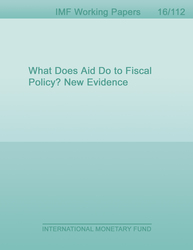
What Does Aid Do to Fiscal Policy? New Evidence
Foreign aid is a sizable source of government financing for several developing countries and its allocation matters for the conduct of fiscal policy. This paper revisits fiscal effects of shifts in aid dependency in 59 developing countries from 1960 to 2010. It identifies structural shifts in aid dependency: upward shifts (structural increases in aid inflows) and downward shifts (structural decreases in aid inflows). These shifts are treated as shocks in aid dependency and treatment effect methods are used to assess the fiscal effects of aid. It finds that shifts in aid dependency are frequent and have significant fiscal effects. In addition to traditional evidence of tax displacement and “aid illusion,” we show that upward shifts and downward shifts in aid dependency have asymmetric effects on the fiscal accounts. Large aid inflows undermine tax capacity and public investment while large reductions in aid inflows tend to keep recipients’ tax and expenditure ratios unchanged. Moreover, the tax displacement effects tend to be temporary while the impact on expenditure items are persistent. Finally, we find that the undesirable fiscal effects of aid are more pronounced in countries with low governance scores and low absorptive capacity, as well as those with IMF-supported programs.
Publication date: June 2016
ISBN: 9781484382691
$18.00
Add to Cart by clicking price of the language and format you'd like to purchase
Available Languages and Formats
| English |
Prices in red indicate formats that are not yet available but are forthcoming.
Topics covered in this book
This title contains information about the following subjects.
Click on a subject if you would like to see other titles with the same subjects.
Economics- Macroeconomics , Economics- Macroeconomics , Economics / General , Economics / General , International - Economics , International - Economics , Foreign aid , Fiscal policy , Tax displacement , Fungibility , Aid illusion
Summary
Copyright © 2010 - 2024
Powered by:
AIDC



